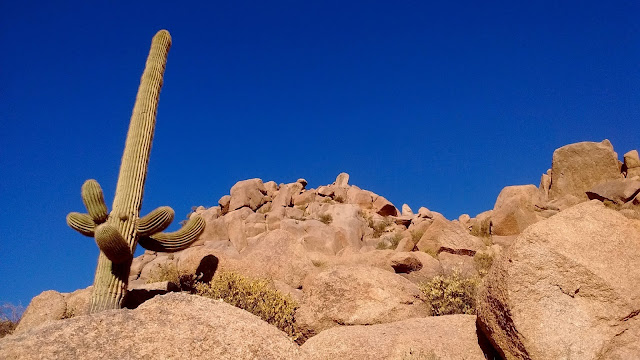Our desert neighborhood is full of bird activity right now. Every morning we wake to a cacophony of sound and see darting motion at every window as birds zip past, frantically carrying out their spring time business. It is not uncommon to see small and mid-sized birds searching the ground for nesting materials and tasty morsels to eat.
What is uncommon is waking up to see a large hawk perched on our small copper reflection pool, surveying the world with beady, yellow eyes. It's also unusual for any bird to hang around for several hours while so much activity is swirling around it, but that is exactly what happened this morning. After capturing some images and admiring this striking visitor, I grabbed my bird book and began the identification process. Mercifully, it stayed long enough for me to take a good, long look.
Judging from the hooked beak and powerful build, this bird is obviously a bird of prey. It is actually one of the fastest flying birds in the world, known for its great skill in navigating tree tops at high speeds while chasing other birds. It was my first close up look at a Cooper's Hawk, and in this case, a juvenile with mottled brown streaks and prominent yellow eyes. This species of hawk experiences a change of eye color as they mature, from pale yellow and even grey, to orange and blood red. I am still researching to understand the benefits of eye color changes.
Cooper's Hawks are not compassionate hunters. They prey on other birds and finish them off by repeatedly squeezing them with their talons. They have also been known to drown their prey by holding them under water until they stop struggling. During nesting season the smaller male is responsible for meal delivery and is perfectly designed for swift flight and tight maneuvering to accomplish the task. His smaller, lighter body coupled with long tail feathers allow this stealthy hunter to glide through an obstacle course of tree limbs with great agility.
 |
| Nictitating Membrane or Third Eyelid |
As you track birds this spring, notice the unique design features that make them each successful desert dwellers. If you were a bird of prey, what physical and ability traits would you want to possess?
References and Resources
All About Birds - Cooper's Hawk
All About Birds - Silent Alert
Hawks Aloft Blog
AskAnNaturalist - Sharp Shinned or Cooper's Hawk
eBird - Identifying Cooper's Hawks
Avian Recon - Cooper Hawk Eye Color
Images: Sharon Pegany
















